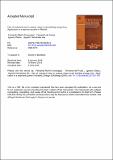Por favor, use este identificador para citar o enlazar a este item:
http://hdl.handle.net/10261/211705COMPARTIR / EXPORTAR:
 SHARE SHARE
 CORE
BASE CORE
BASE
|
|
| Visualizar otros formatos: MARC | Dublin Core | RDF | ORE | MODS | METS | DIDL | DATACITE | |

| Título: | Use of cadastral data to assess urban scale building energy loss. Application to a deprived quarter in Madrid |
Autor: | Martín-Consuegra, Fernando CSIC ORCID ; Frutos, Fernando de; Oteiza San José, Ignacio CSIC ORCID ; Hernández-Aja, Agustín | Palabras clave: | Integrated urban regeneration Energy efficiency Urban data science Cadastre |
Fecha de publicación: | 2018 | Editor: | Elsevier | Citación: | Energy and Buildings 171: 50-63 (2018) | Resumen: | European directives and the objectives of the continent's 2020 strategy identify an urgent need to rehabilitate inefficient urban environments and bring them in line with a twenty-first century social market economy based on low carbon emissions and the harnessing of existing resources. An overarching approach informed by environmental, social and economic integration should be adopted to recover the built heritage and the cities that house it. Urban potential should be accurately assessed to ensure full advantage is taken of existing resources without generating false expectations and the concomitant perverse effects on the objectives of integrated urban regeneration. The development of precision tools to assess the potential for improving energy efficiency in the urban fabric is a priority. This study proposes a method for calculating energy loss across building envelopes based on the exploitation of cadastral data with open source IT tools. The output includes neighbourhood-scale information on the thermal performance of building envelopes and energy dispersion relative to a city's climate based on energy loss calculations. More generally, it establishes energy efficiency of the existing urban fabric from precise energy indicators developed with pooled geometric data collected building by building from the cadastre. The method is verified by analysing the findings for a case study in an area on the outskirts of Madrid characterised by inefficient construction and listed as a deprived neighbourhood, with a population very likely to be subject to energy poverty. The methodology described can be extrapolated to other European cities with cadastres similar to Spain's and in particular to those in temperate Mediterranean climates with cold winters and warm summers. | Versión del editor: | https://doi.org/10.1016/j.enbuild.2018.04.007 | URI: | http://hdl.handle.net/10261/211705 | DOI: | 10.1016/j.enbuild.2018.04.007 | ISSN: | 0378-7788 | E-ISSN: | 1872-6178 |
| Aparece en las colecciones: | (IETCC) Artículos |
Ficheros en este ítem:
| Fichero | Descripción | Tamaño | Formato | |
|---|---|---|---|---|
| usecadastra.pdf | 2,32 MB | Adobe PDF |  Visualizar/Abrir |
CORE Recommender
SCOPUSTM
Citations
27
checked on 16-may-2024
WEB OF SCIENCETM
Citations
21
checked on 27-feb-2024
Page view(s)
150
checked on 20-may-2024
Download(s)
366
checked on 20-may-2024
Google ScholarTM
Check
Altmetric
Altmetric
NOTA: Los ítems de Digital.CSIC están protegidos por copyright, con todos los derechos reservados, a menos que se indique lo contrario.
